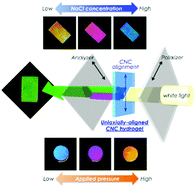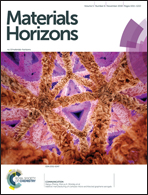Stable and sensitive stimuli-responsive anisotropic hydrogels for sensing ionic strength and pressure†
Abstract
Anisotropic hydrogels with a large mono-domain, nematic organization of cellulose nanocrystals (CNCs) were prepared. External stimuli such as ionic strength and pressure allow the hydrogels to change their shapes anisotropically through swelling/shrinking and expansion/contraction, respectively. These stimuli cause changes in a phase difference for the light passing through them while retaining the monodomain structure, leading to large color changes when the hydrogels are viewed between crossed polarizers.



 Please wait while we load your content...
Please wait while we load your content...